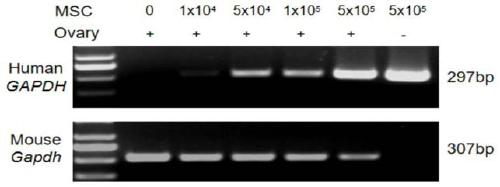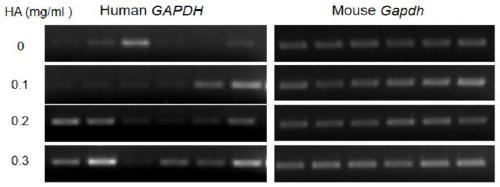Mouse ovarian stem cell transplanting and tracking method
A stem cell and quality stem cell technology, applied in the field of mouse ovarian stem cell transplantation and tracking, can solve the problem of not being able to reflect the survival of transplanted cells as a whole, and achieve the effects of prolonging cell survival time, simple method and high sensitivity
- Summary
- Abstract
- Description
- Claims
- Application Information
AI Technical Summary
Problems solved by technology
Method used
Image
Examples
Embodiment 1
[0048] Example 1: Design of tracking primers for human UCMSCs in mouse ovary
[0049] The DNA sequences of the human and mouse GAPDH genes were downloaded from the NCBI website, and the two sequences were compared using the Clustalw website, and primers were designed for different positions in the two sequences. Primer design was completed using primer 5 software.
[0050] The designed primer sequences are:
[0051]
[0052]
[0053] This pair of primers was attached figure 1 Detection, hGAPDH primers can only amplify the GAPDH gene sequence of human UCMSCs but cannot amplify the mouse gene sequence, and the same mGapdh primer can only amplify the DNA sequence of mouse tissue but cannot amplify the gene sequence in human UCMSCs, These two pairs of primers can be used for cell tracking after non-syngeneic transplantation in humans and mice.
Embodiment 2
[0054] Embodiment 2: UCMSCs mouse ovary orthotopic injection was performed using a Hamilton microinjector, specifically including the following steps:
[0055] S1. Prepare cells: Discard the medium, rinse with PBS three times, digest the cells with 0.25% trypsin, and stop the digestion with complete medium. Pipette into a single cell suspension, centrifuge at 1000rpm for 5min, discard the supernatant, resuspend the cells in 5ml of medium, take 10μl of cells for counting, adjust the cells to an appropriate density with PBS solution, and place the cells on ice when ready.
[0056] S2. The mice were anesthetized with 4% chloral hydrate, the back hair was cut off, and after disinfection, a 1 cm longitudinal incision was made on both sides of the spine, and the skin, fascia, and muscle were cut layer by layer, and the fat pad was gently clamped with curved forceps , exposing both ovaries.
[0057] S3. Slowly draw 10 μl of the cell suspension into the bilateral ovaries along the lo...
Embodiment 3
[0059] Embodiment 3: Utilize TIANGEN kit to extract mouse ovary total DNA, mainly including the following steps:
[0060] S1. The ovaries were collected at each time point in liquid nitrogen, and the DNA was extracted immediately. Add 50 μl of PBS to the ovary and grind it with an electric grinder until no large pieces of tissue can be seen.
[0061] S2. Extract the total DNA according to the instructions of the kit, and dissolve it with TE solution. After mixing, use a Nanogdrop ultra-micro spectrophotometer to detect the DNA concentration and purity, adjust to a final concentration of 8-10 ng / μl with TE solution, and store the extracted DNA at -20°C.
PUM
 Login to View More
Login to View More Abstract
Description
Claims
Application Information
 Login to View More
Login to View More - R&D
- Intellectual Property
- Life Sciences
- Materials
- Tech Scout
- Unparalleled Data Quality
- Higher Quality Content
- 60% Fewer Hallucinations
Browse by: Latest US Patents, China's latest patents, Technical Efficacy Thesaurus, Application Domain, Technology Topic, Popular Technical Reports.
© 2025 PatSnap. All rights reserved.Legal|Privacy policy|Modern Slavery Act Transparency Statement|Sitemap|About US| Contact US: help@patsnap.com



